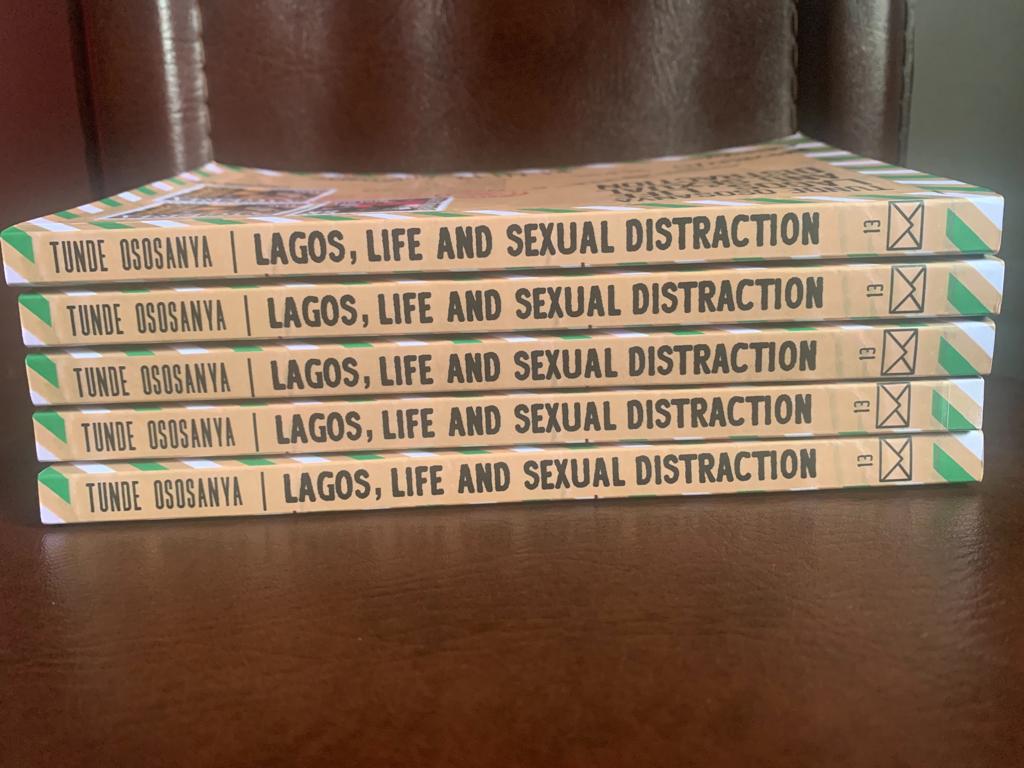Ososanya’s writing comes to life when he portrays adolescent life, its sexual explosions, innocence, guilt, and pranks…
By Chimezie Chika
I have often asked myself what it would mean for a career journalist to write fiction. Fiction is not the exclusive preserve of a certain set of people; it is the exertions of a mind willing to observe life and reveal its deep mysteries. Such observations, if it is written down, must be done with empathy, nuance and intellect. Lagos, Life and Sexual Distraction is a collection of short fiction by Tunde Ososanya, a broadcast journalist at the BBC. The book contains twelve stories set in Lagos and other parts of the country. Perhaps the most significant sign that this is a journalist’s book is not only its geographical expansiveness within the context of Nigeria, but it is the deliberate act of capturing the tragedies and dilemmas of Nigeria’s existence, from elections, to militancy and insurgency.

The first story in the collection, “Transistor Radio,” captures one of the most violent problems of Nigerian’s corporate existence: the Boko Haram insurgency. It explores the anguish and loss of life that attends the inordinate attacks by the terrorist group, as well as its much-vaunted religious motivations. Another story in the book, “Sorrow, Tears, and Blood Live Here,” explores more or less the same dilemma and violence in Nigeria’s northwest, involving bandits and the havoc they wreck on ordinary lives. The reference to Afrobeat legend, Fela, in the title is a pointer to the author’s committed iconoclasm. At the risk of being facetious, this is what one would expect from a journalist’s book.
(Read also: Obinna Udenwe’s The Widow Who Died with Flowers in Her Mouth Features Explorations of Loneliness and Redemption)
Lagos, Life and Sexual Distraction is more than this though. The stories in the book explore all aspects of urban life in Lagos. Ososanya’s roving gaze spares no aspect of the megacity’s variegated machinations of human life. In one of the early stories, “Twenty-Five Letters,” a young indigent student in an elite secondary school in Lagos seeks to hit back at some of his classmates who are children of the political class for their arrogance. He devises a scheme to write twenty-five love letters to the twenty-five girls in his class. The scheme backfires. In another story, “Ending in Tears,” a dreadlocked young boy is accidentally killed in a scuffle involving the police and a group of “Yahoo Boys.” In another, “Wellington Street,” a young man witnesses the death of his friend in a brothel. The two recurring motifs that runs through the collection is the interplay between sensuality and violence. Violence and tragedy—both subtle and stark—is the common thread that holds the collection together. Ososanya’s endings are often his masterstroke; the punchline of each story is in the suspense that often mark the endings.
Electoral violence is the subject of “The Commissioner,” a story in which a young boy’s father nearly renders the family bankrupt in his role as one of the local financiers of his party. The boy’s father finances electoral violence in his blind desire to lead his party to victory in the local government elections he oversees. He, too, is at the receiving end of that same violence at the end of another election. The story shows electoral violence at all its levels, both sanctioned and unsanctioned, and the precariousness of human life in a period that should normally be marked by peace.

In his writing, Tunde Ososanya is drawn to adolescence, for it becomes clear, deep into the book, that almost all his narrators are adolescents and teenagers. It is through their eyes that events in the stories are seen. The teenager’s view of life is often tainted by inexperience. Ososanya’s writing comes to life when he portrays adolescent life, its sexual explosions, innocence, guilt, and pranks. The choice of point of view bestows a certain innocence and naiveté in places where that adolescent sensibility is well-captured. Gems of adolescent intransigence appears in some of the stories. In “The Commissioner,” the young narrator while watching his father drinking with his political cronies says: “I pray they don’t finish the beer because I plan to empty the bottles myself when I clear the table.”
There are illuminating moments, such as in the story, “Ending in Tears,” when the young female narrator, understanding the psychological effect of a failed economic and political system, observes this about her father’s violence after she told him she regretted being born in Nigeria: “Papa didn’t beat me because he was being patriotic. The beating was my punishment for indirectly telling him he was a failure.” These moments of illumination are not always visible in the book. More often, we are treated to a series of discordant vignettes written in a prose well below its peak state. Despite its many failings, “Ending in Tears,” is one of the better stories in the collection. Its exploration of the life of Igbo adolescents is true to life. Igbo words and sentences in the story are accurate, though the author ruins its purpose by explaining the meaning in an annotation below the page—a feature that remains one of the irksome features of the book. In one instance, chin-chin is called a mini-biscuit. Tactics like this detracts attention from the story and infantilises the reader’s intelligence. There is often a clever way to insert explainers within a story.
There is usually a tendency among fiction writers—new authors often fall prey to this—to explain far too much. But it should be noted that a fiction writer who explains too much should go into technical writing where his talents would serve him better. Many stories in the collection show glaring issues. “Twenty-Five Letters,” though it starts well, is poorly conceived. Yet it is a story that would have worked well with better editing. Its final inference shows that the author’s moral stance is well-considered: In oppressive dispensations, the masses will always be at the losing end of confrontations with the political class.
(Read also: Chidiebube onye Okohia’s Of Dark Tides and Darkling Times is a Philosophical Exploration of Life)
The prose poses its own problems. There is a certain inadequacy of expression in many of the stories. The author finds solace in clichés and awkward sentences. The result is that the prose fails to rise to the demands of the stories in the collection and the big subject matters the author chose. No effort is made to give a distinct voice to the adolescent narrators in the stories. Nothing differentiates them. The largely farcical “Wellington Street” stuffs too many themes into too little space. There is randomness in the storytelling and the author’s choice of words is sloppy at best. The author dwells a lot on sex to pornographic proportions—not that we weren’t warned in the book’s title—and its effect is jarring and numbing by turns. Sex in literature is very sensitive and should be written with nuance. The presence or lack of nuance and genuine feeling is what differentiates literary fiction from sensational literature. Sex, and intimations of it, seems to be one of the few notable things in several of the stories, including “Wellington Street,” the ambitiously titled, “Sorrow, Tears and Blood Live Here,” and almost all the others. “The Voice” is another story that could have benefited from greater gestation period and editing.

The best story in the collection, “Mistress of Sorrow,” is a magical realist tale of a female spirit sent to the world of the living to wreck mayhem on men. Here Ososanya gives us a glimpse of his potential as a storyteller. In a way, the story explores the urban legend of mammy water, known in certain circles as Karashika, a highly seductive female spirit out to destroy men. Ososanya includes a clever conceit within which the story is framed: the story of the spirit is actually a story written by a secondary school boy for a class assignment given by his literature teacher. This is where the issue with “Mistress of Sorrow” arises from, for we see that its central conceit fails to create authenticity. The world-wise sophistication of the story couldn’t have been achieved by a teenage boy. How is it possible that a secondary school student in Nigeria could write explicit sex scenes without reprimand from his teacher?
Still, throughout the collection, it is easy to see that Ososanya is a writer that has a grand purpose, even if some of the conceptions would have benefitted from a generous expending of time. The most striking feature of these tales is their Chekhovian feel, bearing the tang of grapevine gossip. Ososanya holds promise here and, with hope, will only get better in the future.
(Buy Lagos, Life and Sexual Distraction here.)
Chimezie Chika’s short stories and essays have appeared in or forthcoming from, amongst other places, The Question Marker, The Republic, The Shallow Tales Review, Isele Magazine, Lolwe, Efiko Magazine, Brittle Paper, and Afrocritik. He is the fiction editor of Ngiga Review. His interests range from culture to history, art, literature, and the environment. You can find him on Twitter @chimeziechika1.




